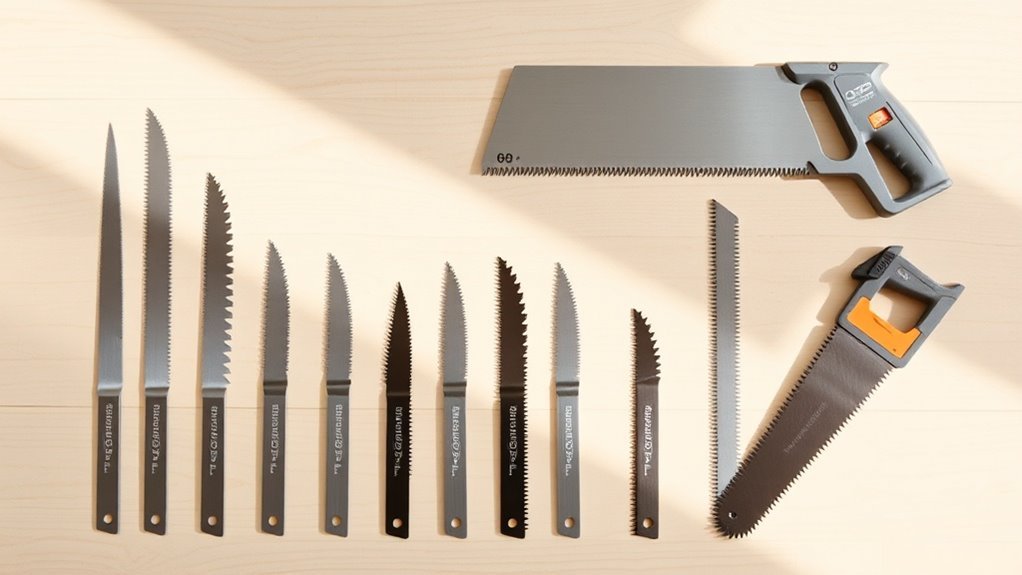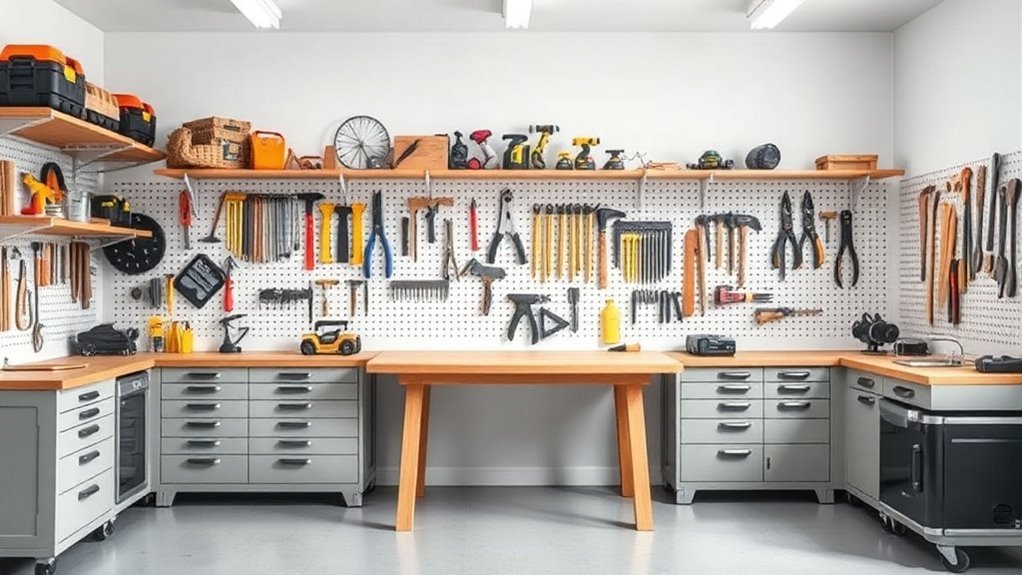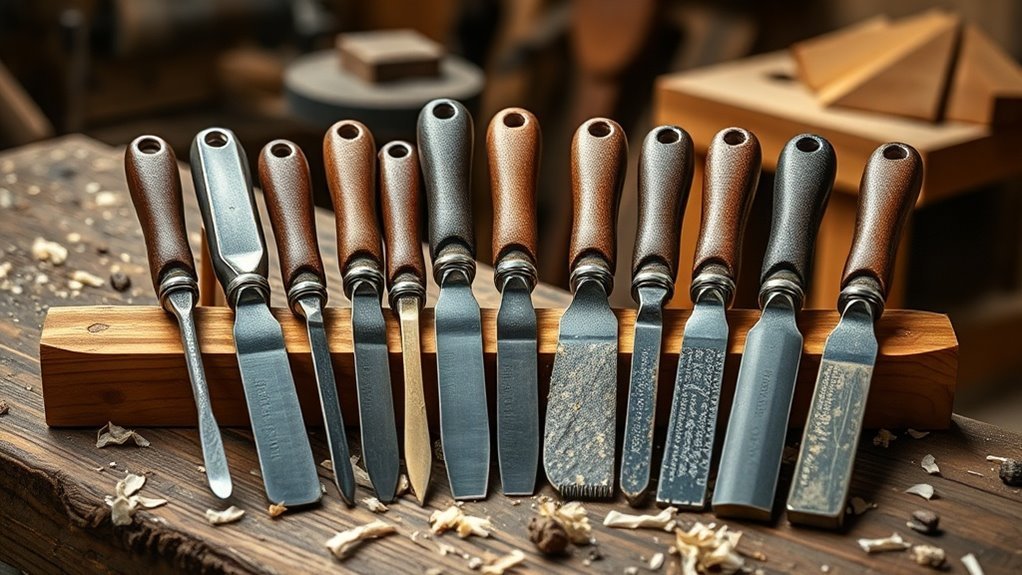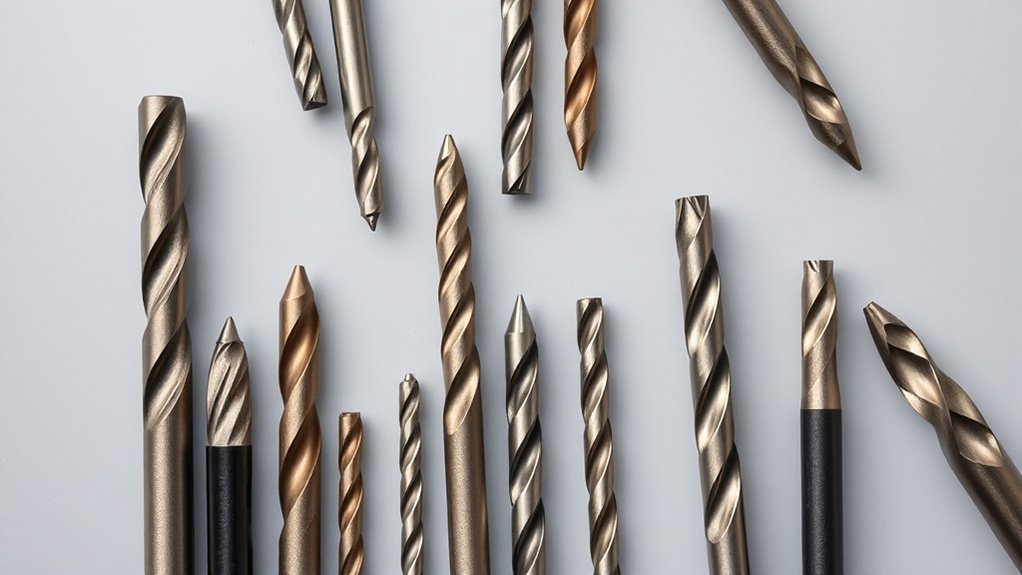Rust Prevention in Long-Term Tool Storage
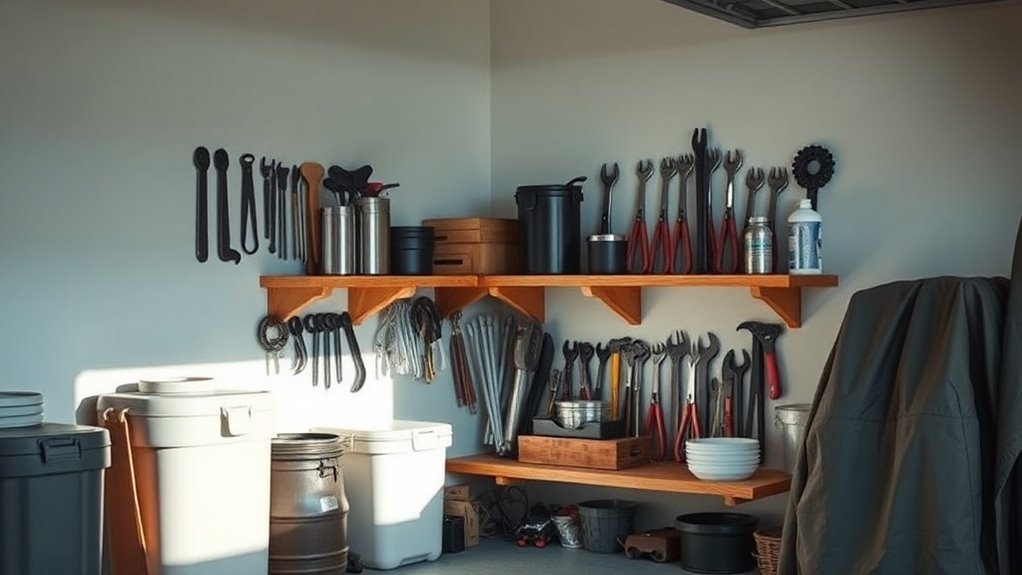
To prevent rust during long-term tool storage, start by cleaning and drying your tools thoroughly. Choose a cool, dry environment with low humidity, ideally below 50%. Consider using protective coatings or rust inhibitors for extra protection against moisture. Regularly inspect your tools for any signs of rust and maintain them by cleaning after use. Proper organization helps too. There’s more to explore about minimizing rust and extending your tools’ lifespan—keep going to find out!
Key Takeaways
- Clean and dry tools thoroughly before storage to remove moisture and prevent rust formation.
- Store tools in a cool, dry environment with humidity levels below 50% to minimize rust risk.
- Utilize protective coatings or rust inhibitors to create a moisture barrier on tool surfaces.
- Organize tools properly to ensure airflow and reduce stagnant humidity around them.
- Conduct regular inspections for rust and perform routine maintenance to prolong tool lifespan.
Understanding Rust and Its Causes
When you understand rust and its causes, you can better protect your tools.
Rust forms when iron and oxygen react in the presence of moisture. This chemical reaction, called oxidation, weakens your tools over time. High humidity, temperature fluctuations, and exposure to water accelerate rust development.
Rust occurs when iron and oxygen react with moisture, leading to oxidation that gradually weakens your tools over time.
Even the oils and residues left on tools can trap moisture, promoting corrosion. It’s critical to recognize that rust can occur not just from rain or direct moisture but simply from the air’s humidity.
If you store tools in damp areas, the risk increases. You can minimize these threats by keeping your tools clean and dry, regardless of where they’re stored. Implementing proper tool storage techniques can further safeguard your equipment from rust.
Understanding these factors is the first step toward preserving your valuable equipment.
Cleaning and Drying Tools Before Storage
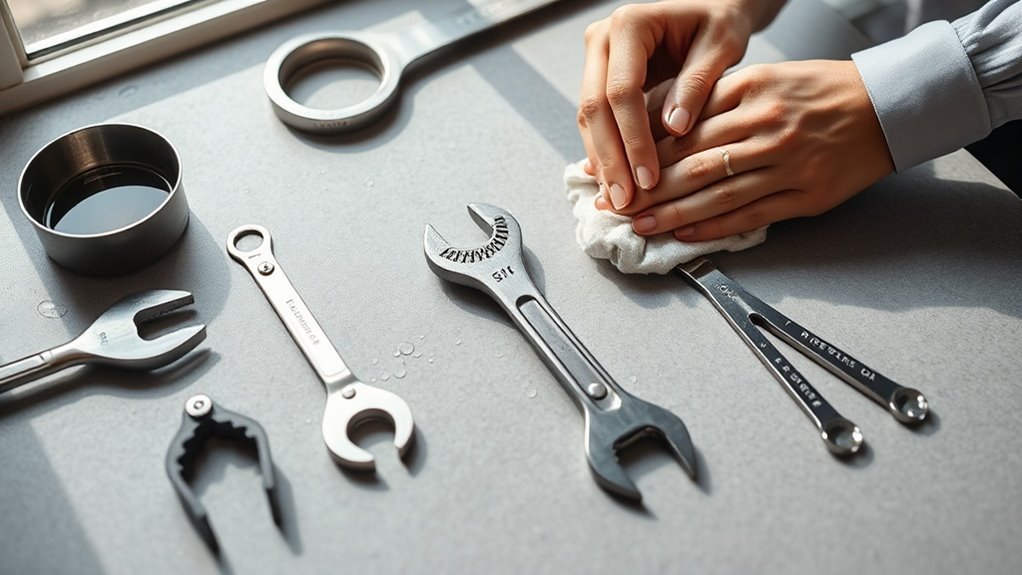
Before storing your tools, it’s essential to clean them properly to remove any dirt or moisture that can lead to rust.
You’ll want to use the right techniques to guarantee they’re spotless and ready for storage.
After cleaning, effective drying methods will help lock out moisture and protect your tools. Regular maintenance, including checking for rust, is crucial to the longevity of your tools.
Proper Cleaning Techniques
To keep rust at bay, you’ll want to make certain your tools are properly cleaned and dried before storing them away. Start by wiping off any dirt, dust, or grease using a clean cloth or scrub brush.
For tougher grime, a mild soap solution works wonders—just remember to rinse thoroughly to eliminate residue. It’s essential to address rust spots immediately; use fine steel wool or rust remover specifically designed for your tool’s material.
Make sure you pay attention to joints and crevices where moisture can linger. After cleaning, inspect each tool for damage or wear.
Effective Drying Methods
How can you guarantee your tools dry effectively after cleaning? Start by using a clean, lint-free cloth to wipe off excess water immediately after washing.
For stubborn moisture, consider using compressed air to blow out any hidden water from crevices. If you’re cleaning larger tools, place them in a warm, dry area, and let them air dry fully before storage.
A heat gun on low can help speed up the process, but be cautious to avoid overheating any plastic parts. If the weather permits, drying outside on a sunny day can work wonders.
Finally, verify your tools are completely dry to prevent rust—a little extra effort in drying can make all the difference in their longevity.
Choosing the Right Storage Environment

When it comes to preventing rust, the storage environment for your tools plays an essential role. You need to evaluate factors like temperature, humidity, and airflow to keep them in top shape. Additionally, avoiding direct sunlight can help protect your tools from unnecessary wear and moisture build-up. Understanding local climate conditions is vital in selecting the right storage solutions that will enhance tool longevity.
Temperature and Humidity Control
Although you mightn’t realize it, the temperature and humidity of your storage environment play an essential role in preventing rust on your tools.
Ideally, keep your storage area cool and dry. Aim for a temperature between 50°F and 70°F, as extreme heat can lead to moisture build-up.
Humidity levels should preferably stay below 50%. High humidity encourages rust formation, especially in metal tools. If your garage or shed tends to be damp, consider investing in a dehumidifier.
Conversely, too dry conditions can also affect your tools negatively, causing some materials to weaken or crack.
Ventilation and Airflow
To effectively prevent rust on your tools, proper ventilation and airflow are essential in your storage environment. Stagnant, humid air can create the perfect conditions for rust to form.
Here are some tips to improve airflow:
- Use breathable storage containers: Opt for cabinets or boxes with slotted designs for better air circulation.
- Position tools away from walls: Leave space between surfaces to allow air to flow around your tools.
- Install vents or fans: Depending on your storage area, adding vents or small fans can considerably enhance airflow.
- Monitor airflow regularly: Check your storage environment periodically to verify air movement remains effective.
Avoiding Direct Sunlight
While it might be tempting to store your tools in a bright and sunny spot, exposing them to direct sunlight can lead to rust and damage. The heat and UV rays can cause materials to degrade, weakening your tools over time.
Instead, choose a storage location that’s cool and shaded, minimizing temperature fluctuations. If you must store in a well-lit area, consider using protective covers or tarps that block sunlight. Additionally, avoid placing tools against windows or in areas where they’ll be directly hit by sunlight.
Utilizing Protective Coatings
When you want to protect your tools from rust, one effective solution is applying a protective coating.
Protecting your tools from rust is essential, and a protective coating is a highly effective solution.
These coatings create a barrier between your tools and moisture, greatly reducing the chances of rust forming.
Here are a few types you might consider:
- Oil-based Coatings: Provides a tough layer that’s resistant to water.
- Wax-based Coatings: Offers a natural option, easy to apply and reapply.
- Acrylic Sealants: Dries clear and is great for a durable finish.
- Rust-inhibiting Spray: Quickly covers tools and protects against corrosion.
Selecting the right coating can improve your tools’ lifespan, ensuring they remain functional and ready to use for years to come.
Don’t overlook this important step in tool maintenance!
The Role of Desiccants in Preventing Moisture
Desiccants play an important role in preventing moisture buildup in your tool storage, making them an essential component for rust prevention.
These materials absorb excess humidity from the air, keeping the environment dry and reducing the risk of rust. When you place desiccants like silica gel or activated clay with your tools, they help maintain ideal conditions inside your storage area.
Remember to monitor the effectiveness of desiccants regularly. Once they become saturated and lose their moisture-absorbing capabilities, you’ll need to replace or recharge them to guarantee they continue doing their job.
Regular Inspections and Maintenance
Maintaining a dry environment with tools safeguarded from moisture is only part of the equation for preventing rust. Regular inspections and maintenance are vital for keeping your tools in top condition.
By routinely checking your tools, you can identify early signs of rust or damage that may lead to more significant issues down the line.
Make sure to:
- Inspect metal surfaces for any signs of rust or corrosion.
- Clean tools thoroughly after use to remove dirt and residue.
- Regularly sharpen edges and lubricate moving parts to prevent wear.
- Store tools properly off the ground and in protective cases when not in use.
Additionally, following manufacturer guidelines for maintenance can greatly enhance your tool’s longevity. These simple practices can greatly extend the life of your tools, preventing rust from becoming a persistent problem.
Using Rust Inhibitors for Extra Protection
To guarantee your tools remain rust-free, using rust inhibitors can be an effective strategy. These products create a protective barrier against moisture and other corrosive elements that cause rust.
You can choose between various forms, such as sprays, oils, or waxes, depending on your tools and storage conditions. Applying a rust inhibitor is typically a straightforward task: clean your tools first, then apply the inhibitor evenly, ensuring complete coverage.
Remember to let it dry completely before storing your tools away. Regular reapplication, especially if you frequently access your tools, can enhance their protection.
The Importance of Proper Tool Organization
While having rust inhibitors is essential for protecting your tools, proper organization plays a crucial role in maintaining their condition as well.
When your tools are organized, you not only prevent rust but also enhance efficiency and accessibility. Here are a few reasons why you should prioritize tool organization:
- Easier Access: Quickly find the tool you need instead of rummaging through a cluttered space.
- Minimized Damage: Proper spacing prevents tools from knocking against each other, reducing wear.
- Routine Inspection: A well-organized setup allows you to regularly check for signs of rust or damage.
- Enhanced Longevity: Keeping tools stored correctly can extend their lifespan, saving you money in the long run.
Additionally, implementing modular storage solutions can further optimize your tool organization, making it easier to adapt your storage to specific needs and workflows.
Seasonal Considerations for Tool Storage
As seasons change, so do the specific needs for tool storage and protection.
In warmer months, humidity can rise, increasing the risk of rust. Make certain to store your tools in a dry, climate-controlled environment. Use rust inhibitors or protective coatings during this time to further shield against moisture.
During warmer months, ensure tools are stored in a dry environment to prevent rust and use protective coatings for added moisture defense.
When winter arrives, make certain tools are stored in a warm area to prevent frost buildup, which can lead to corrosion. Regularly check for any signs of rust and take action immediately.
Spring and fall bring fluctuations in temperature and moisture levels, so review your storage methods and adjust accordingly. Properly storing your tools can enhance your gardening efficiency, similar to how mulching tools can improve plant health and reduce maintenance efforts.
Keeping your tools clean and well-oiled year-round will help them withstand these seasonal changes and remain in great condition.
Questions
Can I Use Household Oils to Protect Tools From Rust?
Yes, you can use household oils like linseed or mineral oil to protect your tools from rust. Just apply a thin layer and make certain they’re clean and dry before storage to maximize protection.
How Often Should I Check on Stored Tools?
Just like a gardener tends to their plants, you should check on your stored tools every few months. This way, you can spot any issues early and keep them in great shape for when you need them.
Are Certain Materials More Prone to Rust Than Others?
Yes, certain materials are more prone to rust than others. Items made of iron and untreated steel tend to rust easily, while stainless steel or aluminum are less susceptible. Always consider the material when storing tools.
What’s the Best Way to Restore Rusted Tools?
To restore rusted tools, start by scrubbing them with steel wool or a wire brush. Then, soak in vinegar or use a rust remover, followed by thorough cleaning and oiling to protect against future rust.
Do I Need a Climate-Controlled Environment for Tool Storage?
You don’t absolutely need a climate-controlled environment for tool storage, but it’s like trying to keep ice cream from melting in a furnace—your tools could thank you for a bit of temperature control!
Conclusion
In the battle against rust, your tools deserve the best protection possible. By following these strategies—like cleaning, choosing the right environment, and using protective coatings—you’ll keep them in prime condition for years to come. Just as a gardener nurtures their plants, a little care for your tools goes a long way. Don’t let rust steal your hard-earned investments; with vigilance and organization, you can guarantee they’re always ready for your next project.



